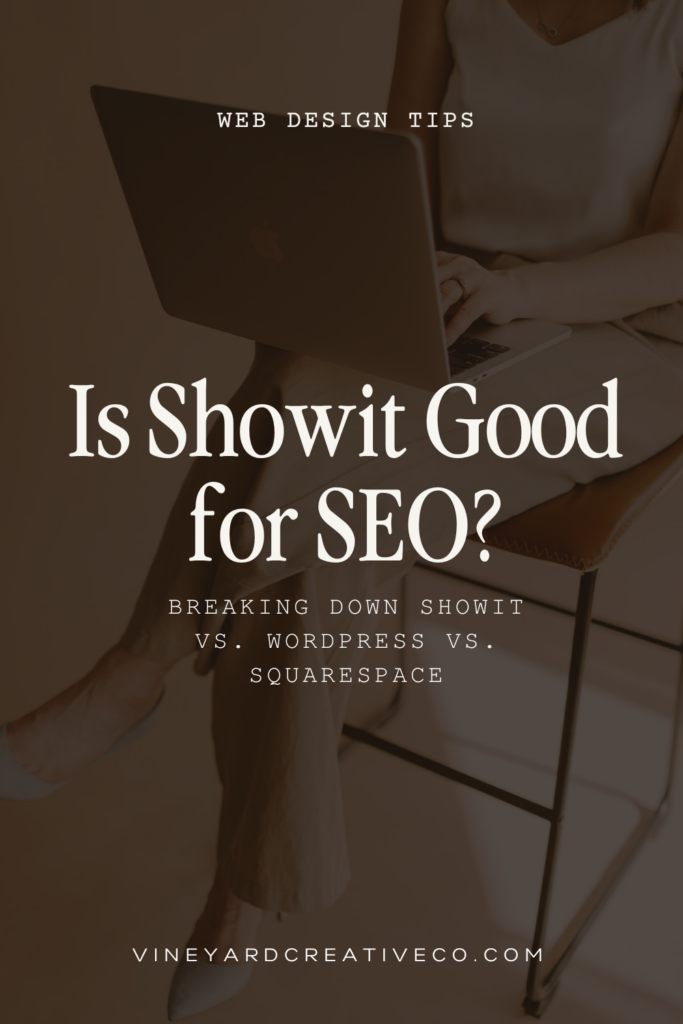Your resident Showit brand and web designer. I've helped dozens of creatives stand out online and create a sustainable digital presence.
I'm Laurel.
MY FAVORITE RESOURCES
WORK WITH ME
Browse the SHOP
There’s no denying Showit is an incredible platform for aesthetics, ease of use, and limitless design capabilities. But is Showit good for SEO? Or is it lagging behind in SEO capabilities to actually get you found online? Let’s talk about how Showit compares to other platforms when it comes to SEO.
Spoiler – it’s my preferred web design platform!
📌 Pin for Later 👇

What makes up good SEO?
Let’s first understand what good SEO even means. How does Google decide the order of search results? Knowing what actually makes for a search engine optimized website is crucial to understanding how Showit compares. Here’s a list of the top things that go into a website that Google wants to show people in search results:
User Experience
User experience (UX) is crucial to great SEO. Google tracks how long people are sticking around on your website and whether they’re running into things like broken links or dead-ends. Creating a website that makes for a smooth user experience is crucial to both Google and your website visitors. It increases the chances of your website traffic converting.
Content Strategy
Content is king, especially on your website. From page content to blog posts, the amount of “helpful” content you provide is going to be crucial to showing up in search results. One key piece in growing the amount of keywords you’re ranking for is to continue to grow your authority with high-quality, well-optimized blog posts.
Keyword Strategy
Closely linked with your content strategy, keyword strategy is an important part of ranking in search results. Carefully chosen keywords for each page on your website will help you rank for terms that people are actually searching for. Avoid keywords with super high volume – huge websites are already vying for the top spots and you probably won’t be able to compete. Find keywords with lower competition, making them easier to rank for. I use Ubersuggest to do keyword research.
Page Speed
Page speed is an important part of SEO because in today’s fast paced world, no one wants to wait for your site to load, and Google knows that. Ensuring that our sites are loading quickly can help Google bring our site higher to the top of results. Use PageSpeed Insights to find out how fast your site loads on mobile and desktop.
Images
Your images are an important part of your SEO strategy because images can also rank in search results! Ever notice the “images” tab when Googling something? These are top ranking images that Google is showing based on your query. Many people prefer this tab when looking for visual inspiration. I actually sold a website template from someone who told me they found an image of it this way!
Technical and Code
The technical aspects of SEO are essentially the “how-to” in creating a website that communicates well with Google. Inside the code, you’ll find the essence of how your website communicates with Google’s robots to index your content.
Accessibility
Accessibility is an important part of ensuring that everyone online is able to use your website and consume your content. Google wants to ensure it’s showing content that can be read by screen readers and those with vision impairment, so things like alt text and high contrast text-to-background ratios play into this.
Showit vs WordPress vs Squarespace…which is best for SEO?
Let’s finally answer the question of the hour, “Is Showit good for SEO?!” And of course, compare WordPress and Squarespace capabilities to Showit’s!
WordPress
For many years, WordPress has been the gold-standard for SEO capabilities. This is because there’s almost no setting or function you’re not able to edit and access and it has a large range of plug-ins to help SEO (Yoast is my favorite!)
The drawback with WordPress is that unless you plan to completely custom code everything, you’re going to be stuck with a very unattractive website and spend a lot of time trying to figure out all the settings in the back end.
Squarespace
When Squarespace came on the scene, it provided a very appealing option with its block-style, easily editable, visual builder. While it doesn’t offer the same level of customization and advanced SEO as WordPress, you’ll still have the ability to add SEO titles, meta descriptions, and all the other standard settings that are key to solid SEO.
The largest drawback with Squarespace is its limited design functionality, some of which ties into SEO. For instance, font styles are connected to text tags. Text tags are what communicates to Google which text on your page is the most important. So if you want to have a certain font style on your page, but tag it differently (say H1 at the top and H2 later on down the page), you won’t be able to do that without some custom coding.
Showit
Showit stands out for its fully customizable and user-friendly interface that’s completely drag and drop. Originally designed with photographers in mind, the platform gained popularity among creative businesses of all kinds, and is now a favorite among designers (including me!)
Showit utilizes WordPress hosting for your blog, meaning you get all of its powerful SEO capabilities along with plugins like Yoast to help ensure your posts are optimized. So you can have a beautifully custom designed website with the SEO capabilities WordPress offers. It’s the best of both worlds!
How much does my website platform really matter when it comes to SEO?
A lot less than you might think. While there are definitely some platforms I would not recommend for SEO, the big three (WordPress, Squarespace and Showit) are all going to give you the essential tools you need for SEO. And while WordPress may still have an edge on the rest, an ugly website that’s impossible to edit isn’t going to get you very far and won’t impress potential clients.
So I’m here to let you know not to overthink this one! You do not need to change web providers for the sake of SEO. Your keyword strategy, knowing how to navigate the SEO settings on your platform, and continually posting high-quality blog content is going to get you so much further than choosing the “best” website platform.
How can I work on my SEO with Showit?
Curious how to navigate your SEO settings inside Showit? I’ve made a video giving you an inside look into how to navigate them:
Here’s a quick checklist to keep in mind when building out a page in Showit:
Add SEO Titles and Meta Descriptions. Providing titles and meta descriptions to each page using the keywords you’re trying to rank for will be key to improving your ranking and communicating what the page content is about to Google.
Add Alt Text to each image, and compress before uploading. Alt text is a key part of accessibility, and will also increase the chances your images show up in search results. Compressing the images before uploading will help with your overall site speed! Use CompressPNG or Tinify to do that!
Add correct text tags. Tagging your text will help Google correctly categorize the page and is crucial for your SEO. H1 should be used only once per page and at the top. H2 should be for the next largest heading, and H3 for subheadings. Use ‘p’ for paragraphs and button text, ‘Nav’ for your navigation and footer menus (Think Home, About, Services pages etc.), and ‘Div’ for decorative text that shouldn’t be indexed.
Submit your sitemap to Google Search Console. This will help Google understand the layout of your website so it can crawl your page. Then you get traffic more quickly! Here’s how to access your sitemap.
Get more tips in my free Showit SEO checklist!
Looking for help creating or optimizing your Showit website for SEO?
My Showit SEO services and Brand and Web Design services are built just for you! Whether you’re looking for a brand new website with a solid SEO strategy from day one, or to optimize the one you currently have, I’d love to help you grow your organic traffic. Reach out and let’s chat!
*This blog post may contain affiliate links. I never recommend anything I don’t personally love and use myself for my clients or in my own business!
Is Showit Good for SEO?
May 7, 2024
Date published:
Filed under

AFFILIATE DISCLOSURE
Some links across my website may be affiliate links, meaning I receive a portion of any sales made through them. I never recommend any product or service that I don't wholeheartedly believe in and use in my own business.
Leave a Reply Cancel reply
LOVE What You Just Read?
☕️ buy me a virtual coffee!
I love supporting you with free resources like this! Keep the creativity going and throw some caffeine my way if you want 😉
The Newsletter that
you'll actually want to open
Each week I share design and marketing tips, a roundup of my favorite resources, and an inside look at entrepreneurship the slow way.
get weekly growth tips in your inbox
work with me learn from me
Vineyard creative co is a brand, web design and marketing agency serving creative service providers. Based in Cincinnati Ohio, serving clients worldwide.
student login
Join the Slow Growth Club
weekly sustainable marketing tips, trends and heart-to-hearts from one creative to another